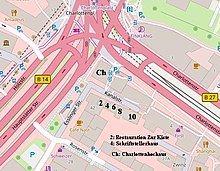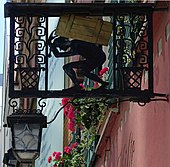Restoration to the box
The restaurant zur Kiste , today Weinstube Zur Kiste, is a Swabian restaurant on Kanalstrasse 2 in Stuttgart-Mitte . The house was built as a residential building in 1740–1760 and has been run as a restaurant since 1843.
location
The “Restauration zur Kiste” is located in Kanalstrasse 2 opposite the Charlottenhochhaus, through which a passage leads to Charlottenstrasse and a staircase to the Charlottenplatz underground station.
The originally almost 200-meter-long Kanalstrasse used to stretch from Esslinger Strasse to Weberstrasse. Today's street, shortened to 40 meters, on the northern edge of the Bohnenviertel in Stuttgart begins after the corner house at Esslinger Straße 42 and ends as a dead end. The street is only built on one side on the south side and consists of the 5 houses with the numbers 2–10. Apart from the elongated building at Kanalstrasse 10, the 5–8 meter wide houses have retained their "towel shape".
The Stuttgart theater critic Siegfried Melchinger described the current location of the "box" in 1993:
- “The small house in the narrow alley is shaded by a modern giant block that could just as easily be in Milan or Chicago. It is squeezed into a row of abandoned houses, none of which is worth mentioning. Vis avis had dropped the bombs. Coziness once nested here. It is said that there were more farms than houses here. The man from Stuttgart drank his quarter here. The legend tells that the last king, Wilhelm with the beard - when I was a boy I saw him walking with his dogs in the Königstrasse - every now and then appeared in the 'box' to drink a quarter. He lived a block away in his now rebuilt private palace. The War Ministry was once located in between. "
history
The narrow building of the " Restoration to the box" consists of 5 floors and 3 window axes. It was built in 1740–1760 as a two-story residential building. The house is plastered in a reddish shade. The plaster is decorated with white ornaments in sgraffito (scratch plaster). Above the ground floor, the house bears the white sgraffito lettering "Restauration zur Kiste". The white-framed windows have green hinged shutters.
Ringwood
Johann Ringwald (1802-1858) was the body coach of King Wilhelm I. As he believed that as a wage coachman he could better feed his 7 children (6 daughters and 1 son), he asked the king in 1843 to be released. He did not want to lose his tried and tested coachman and therefore suggested that he buy the little house on Kanalstrasse 2 in order to set up a beer bar there. Ringwald had the builder Eckert add one story to the two-story house. While he continued to work as a royal coachman, his wife Eva Ringwald, nee. Fritz (1804–1875) and his daughters founded the restaurant, which soon flourished and was run as a restaurant. When Ringwald died in 1858 at the age of 55, his wife took over the management of the restaurant. In 1875, the year she died, the restaurateur Emil Böhme married one of the Ringwald daughters and continued to run the restaurant with her under the name “Restauration zur Kiste”.
Bräuninger
In 1893 Wilhelm Bräuninger the Elder (* 1868) bought the inn from Emil Böhme. In 1902 the new owner had the house extended by a gable floor by the architect Storz. The gable triangle has an oval niche with the figure of a black raven, flanked by the owner's initials WB. After Wilhelm Bräuninger's death, his wife took over management of the business, which she transferred to her son Wilhelm Bräuninger the Younger (* 1922) in 1949.
In 1993 he handed over the "box" to his long-time employee Rose Wenger and her daughter Heike Hauschke, who have maintained the "box tradition" to this day. In more recent times, the house has been extended by a fifth floor, which is lit through a row of seven windows over the entire width of the building.
In 2016, Wolfgang Chur, formerly a member of the management of the Bosch Group , sang the praise of the gastronomy of the traditional Swabian economy in his literary Stuttgart Guide :
- "Those in the know know that you can sit comfortably in the crate soaked in the past in the wood-paneled room with benches and tables polished to a polished finish with numerous trouser bottoms and sleeves, and enjoy a meal in this haven of Swabian cosiness like in the past. The meat fritters with potato salad taste like they do at home, and Maultaschen , roast beef or Gaisburger marsch are also popular. Connoisseurs order Einsundeins, a Maultasche and a meat cake with delicious fried potatoes. It's good to be here, especially with a quarter of wine, or two or three. "
Public house sign
The wrought-iron pub sign shows the black silhouette of a porter between two stylized plant pots. He carries a golden box on his deeply bent back, from which the inn owes its name. According to the legend, the name goes back to an oat chest that was used to feed the horses in front of the house (see also Wilhelm Hauff ). According to another tradition, students are said to have hung a gilded box above their regular place in the inn as a sign of the royal loan that the landlord had received.
Stammtisch of the thirteen
For many years the regulars' table of the thirteen met on the first floor of the “box”. Artists, politicians, lawyers and writers met every Monday to talk and discuss. The members of the men's club included the writers and journalists Hermann Mostar , Friedrich Sieburg , Thaddäus Troll and Werner Finck , the historian Eberhard Jäckel , the general manager of the Württemberg State Theaters Walter Erich Schäfer and the publishing director of the German publishing house Frank-Ulrich Planitz .
Wilhelm Hauff
From October 1824 to April 1826 the poet Wilhelm Hauff was employed as court master by Ernst von Hügel, President of the War Council, in Stuttgart . He lived in the old war ministry on Charlottenplatz across from the inn zur Kiste. In his novella “The Last Knights of Marienburg” from 1827, the economy is said to have been part of the plot. The amendment should also show that the name of the inn can be traced back to an oat chest that once stood in the house entrance. However, this information is questionable as the relevant passages cannot be found in the text of the amendment.
literature
- Wilhelm Bräuninger (Ed.): 150 years of the Zur Kiste wine tavern, 100 years of Bräuninger: 1843–1993. Weinstube Zur Kiste, Stuttgart 1993, DNB 940986086 .
- Wolfgang Chur: "Happy Stuttgart, kindly accept the stranger!": Entertaining literary walks through the Swabian metropolis. JG Seume Verlag, Leipzig 2016, ISBN 978-3-9814045-8-6 , pp. 18-21.
- Irene Ferchl: Stuttgart. Literary milestones in the city of books. Klett-Cotta, Stuttgart 2000, ISBN 3-608-94267-X , pp. 162-163.
- Hubert Giesen: The regulars' table of the thirteen. In: Karin von Maur (ed.): Small stories from Stuttgart. Engelhorn-Verlag, Stuttgart 1990, ISBN 3-87203-076-0 , pp. 101-110.
- Gustav Wais: Old Stuttgart's buildings in the picture: 640 pictures, including 2 colored ones, with explanations of city history, architectural history and art history. Stuttgart 1951. (Reprint: Frankfurt am Main 1977, ISBN 3-8035-8918-5 , p. 583.)
Web links
Footnotes
- ↑ # Bräuninger 1993 , p. 30.
- ↑ Wilhelm with the beard: Wilhelm II. , Private palace: Wilhelmspalais , today City Palace, Ministry of War: it was on the site of today's Charlottenhochhaus.
- ^ Archives of the House of Württemberg Altshausen Castle .
- ^ # Bräuninger 1993 , pp. 67–68, Stuttgarter Adressbücher 1829–1894.
- ↑ #Chur 2016 , #Ferchl 2000 .
- ↑ #Chur 2016 , pp. 18-19.
- ↑ #Chur 2016 , p. 19, #Ferchl 2000 , p. 163, #Giesen 1990 .
- ↑ #Wais 1951.1 .
Coordinates: 48 ° 46 '30.4 " N , 9 ° 10' 58.9" E





